Lesson
News / Blog
Other Menus
Buddhist Kakejkiku
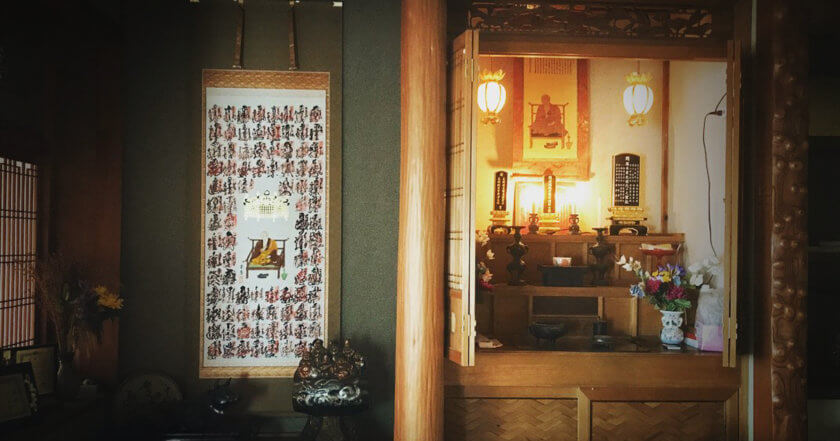
Introduction
I would like to introduce butsuji-gake/ Buddhist kakejiku on this occasion.
‘Butsuji-gake’, a type of kakejiku has been displayed at Buddhist ceremonies in Japan the nation of which is predominantly Buddhist over a long period of time.
The most major Buddhist ceremony has to be ‘hōji / Buddhist memorial service’. ‘Obon’ taken place in July to August and ‘higan’ celebrated during the spring and autumnal equinox annually are the other examples of key Buddhist event.
Regarding Buddhist ceremony, for instance Buddhist memorial service, I imagine the service is held on the day, with a manner in which relatives gather and sit on a floor cushion in a Japanese-style room with a Buddhist altar to listen to the sutra the invited monk who is sitting in front of the altar chants.
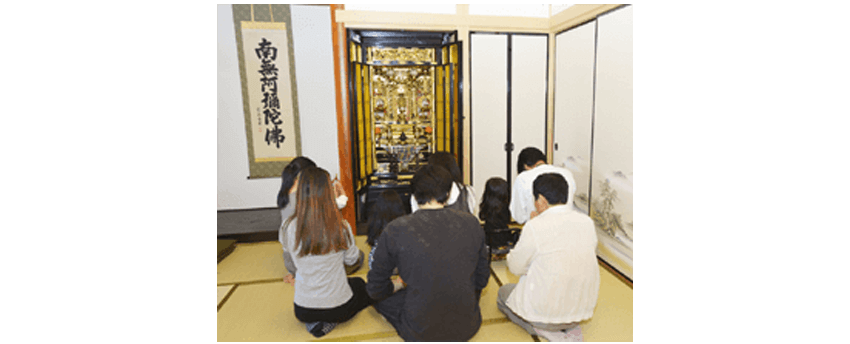
I wonder if you manage to recall what kind of kakejiku was displayed in the alcove next to the altar the monk was chanting at.
Let’s say, It could have been ‘Na mu…something’, and this ‘something’ is illegible typically for many of us.. Nevertheless it is the sign of butsuji-gake.
Or a kakejiku representing a number of Buddhas called ‘jūsan butsu’ which is also butsuji-gake.
Other possibility is a kakejiku mounted with an artwork of goshūins collected by making a pilgrimage to temples such as ‘Shikoku pilgrimage’ and it is also butsuji-gake. We recently received a request of mounting a shikoku pilgrimage kakejiku from a Swiss customer.
The reason why butsuji-gake varies to such an extent is the right one to display will depend on the denomination. Furthermore, the sound choice changes regionally even in the same denomination. For example, in Hyōgo prefecture where our company is located, Awaji-Shima Island in the south and Tajima province in the north sharing the same denomination Shingon sect disagree each other with the choice. Intriguing isn’t it. Uniquely enough, Hyōgo prefecture consists of the former five provinces and as an individual custom of each area still remains, these differences understandably occur.
Knowing the fact, many of you may become doubtful thinking, ‘Is my butsuji-gake in the alcove the right one for my denomination?’ Unexpectedly enough, majority of people have no idea about what their kakejiku stands for although they exhibit one in their alcove at Buddhist memorial service. In reality, there have been cases of being reprimanded by the monk invited for the ceremony, being told ‘This is a kakejiku, not displayable for our denomination!’ as the host, unbeknown to them, has been displaying the wrong one.
Receiving frequent consultations over those issues, I decided to explain about ‘butsuji-gake’ into details.
The Basics of Buddhism
Firstly, for the better understanding, I would like to introduce the basics of Buddhism prior to explicating butsuji-gake.
Buddhism is a religion founded by Shakyamuni / Buddha in ancient India. After the demise of the Buddha the religion separated into two denominations, Mahayana and Theravada Buddhism.
In brief, two deferent directions divided the religion. Theravada Buddhism follows the teachings of Shakyamuni as it is and possibly the religion could whereas Mahayana Buddhism widen the interpretation of the teachings in response to the changing of times aiming to save more people. The approach of Mahayana Buddhism which interprets the teachings of Shakyamuni in various ways on a basis of circumstances brought out multifarious Buddhist scriptures.
Later on, Theravada Buddhism was introduced southward, South East Asia while Mahayana Buddhism spread into China where ideologies of Taoism and Confucianism had already existed. Therefore, Mahayana Buddhism was accepted in the country after Chinalization on the basis of those existing ideologies.
Then via the Korean Peninsula the Buddhism that went through Chinalization was introduced into Japan where its native religion Shinto had been worshipped and the Chinalized religion was still adapted after having this time, Japanification . The Mahayana Buddhism which was adjusted to Japanese notion has never stopped transforming itself throughout many centuries and up to the present Japanese history.
A slight alteration to a religious principle influenced by the custom of the preaching region is rather common. Especially for Buddhism, as Pali and Sanskrit the original languages for the Buddhism in India were translated into Chinese and it is impossible to translate the meaning of original words 100%. So assumingly, there have been significant changes in the principle when the religion arrived to China.
For that reason, the original Buddhism that Buddha began and the Buddhism currently practiced in Japan partly but remarkably differ from each other and presumably that makes the transformation of the religion and so on incomprehensible to fully understand. I myself also do not perfectly comprehend the whole picture of Buddhism. It is such a broad and deep world.
This time, I would like to introduce only the essence of Buddhism I extracted which is vital to explain Japanese butsuji-gake.
The Purpose of Buddhism
I am going to start off with a basic question ‘What are the purpose and goal of Buddhism?’ which surprisingly, most of us have no clue.
The answer is ‘Achieving enlightenment / attain Buddhahood’.
However, you would wonder why we need to?
Notions of Buddhism, Rokudō, Rikudō / The Six Realms and Rinne Tenshō / Reincarnation associate with the answer.
The fundamental belief of Buddhism is that all living things eternally wonder in six realms called Rokudō repeating reincarnation, the cycle of birth and death and that is called Rinne Tenshō.
Rokudō / The Six Realms
What kind of realms are the six realms called Rokudō ?
Ten-Dō / Deva Realm: A realm where celestial beings with a remarkable longevity that are superior to human being live and there are hardly any sufferings compares to Ningen-dō. It sounds rather good for me yet it is said that death is still there in the realm as the dwellers have not achieved enlightenment and which realm they are to reincarnate is unknown.
Ningen-Dō / Human Realm: A realm we live. Somewhat our human realm takes the second place doesn’t it.
Shura-Dō / Asura Realm : A realm with full of endless fights broken out by continuous and uncontrollable fury and jealousy.
Chikushō-Dō / Animal Realm: A realm of animal under the law of the jungle. Imagine surviving in a harsh animal kingdom that is far cry from a peaceful life of pets. This is on the whole the world where the dwellers struggle to live and never feel at ease.
Gaki-Dō / Hungry Ghosts Realm: Many kind of hungry ghosts that feel hungry all the time are around. It is said that their appetite never be fulfilled after eating and when they take some food it burns to ashes.
Jigoku-Dō / Hell Realm: I leave it to your imagination.
Across those six realms, we apparently transmigrate to one of the realms based on the good deeds and bad deeds accumulated in our previous life which means our current life is the result of the previous one. Rinne Tenshō is the belief that fundamentally, lives must revolve around the eternal circle of transmigration among the six realms.
Well.. All realms except Ten-Dō and Ningen-Dō sound horrendous. I could say that Ningen-Dō seems more or less the same as the realms though. If you think that way, basically there are way too much sufferings and hardship in life aren’t there? Indeed, the fundamental outlook on the world of Buddhism is ‘Let’s escape from this harsh world.’ and the method is ‘achieving enlightenment to attain Buddhahood’.
That is the basic conception of and views on the world of Buddhism I was going to introduce. As I mentioned earlier, denomination in Japan varies due to the different interpretations made throughout the history still I suppose it would be easier to understand the differences of denominations if considered on the basis of the outlook of Buddhism.
Now then, let’s move on to the main subject, a guidance of butsuji-gake.
Jizō / Scripted Icon
Jizō is the most common type of butsuji-gake consisting of letters, calligraphy called ‘Myōgō / daimoku to which ‘namu’ the letters are generally prefixed. Letters following ‘namu’ differ according to the denomination as in most cases, the letters must be Honzon / principal image of Buddha of a sect to invoke the Buddha.
Honzon is the principal image of deity placed at both a temple and a family altar which can be a statue, a scripture, a pagoda and a portable charm as well as a carving / painting / mandala / name of Buddha or Bodhisattva.
In short, Honzon is a sectarian principal object of faith with the meaning of ‘the fundamentally holy object ’and listing or chanting the object is believed to bring a blessing.
Basically, ‘namu’ is the transliteration of ‘namas’ in Sanskrit. Pali and Sanskrit were the initial language for India origin Buddhism and through the course of introduction to China, ‘namas’ was transliterated into the Chinese character ‘namu’. The word means ‘I have a faith in you’ ‘Ask for the Deity’s further mercy by being devout’ and chanting a Honzon with the prefixed word represents ‘Having a faith in Honzon. Being devout to Honzon’ to the chanter.
Let me show you the representative Jizō for a Buddhist service and the like of each denomination from a wide range of the scripted icons.
Namu-Amidabutsu…Jōdo Shū, Jōdo Shin Shū, and Tendai Shū / Sect etc.
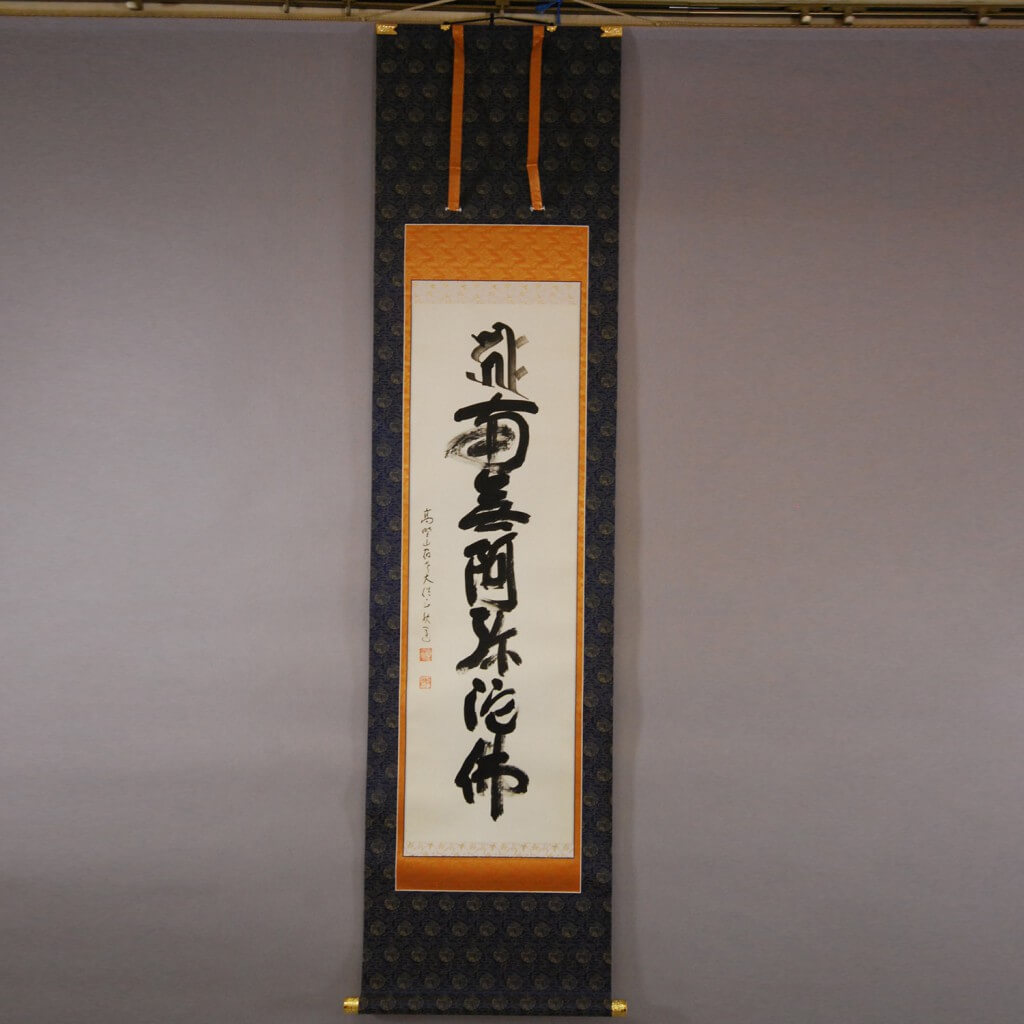
Most certainly, this is the mainstream Jizō in Japan. It is also called ‘Rokuji Myōgō’.
This is the absolute standard Jizō used by Jōdo shū and Jōdo Shin shū in particular.
According to preaching of Jōdo shū and Jōdo Shin shū, by chanting ‘Namu-Amidabutsu’, Amida Nyorai / Amitabha Buddha will come rescue to lead you to the pure land when pass away for that reason Amida Nyorai is revered as the primal deity for the honzon which has the prefix ‘namu’ and is to chant ‘Namu-Amidabutsu’.
Jōdo Shin shū has expanded their influence by Rennyo the descendant of Shinran who is the founder of the denomination. In his teaching, he encouraged people to cherish Jizō rather than wooden and painted images and that contributed to a rapid growth of Rokuji Myōgō’s recognition. Since Rennyo handed a paper on which his hand written ‘Namu-Amidabutsu’ was to numerous people, kakejikus with the calligraphy have been still kept in temples practicing Jōdo Shin shū. – We took a restoration order of one of those once… The kakejiku of the Muromachi period was, not surprisingly, nearly falling apart…
Regarding above-mentioned the Pure Land, it is believed to be the world where Buddha lives and it is not a single land as every Buddha has their own pure land.
Have you ever heard that Amida resides in the Western pure land whereas Yakushi Nyorai/ Bhaisajyaguru lives in Pure Lapis Lazuli and Shaka Nyorai / Shakyamuni is in Ryōzen pure land?
Assumingly, not many people know about it.
I myself acknowledged that after studying Buddhism and I would guess why these lands are not that well known except the western pure land of Amida is there weren’t any descriptions of how to reach those lands in the sutra apart from the land of the Buddha.
The means to go to the Western pure land is written in Muryōju-kyō the treasured sutra of Jōdo shū which is said to be founded by an ascetic monk Hōnen, who had been concerning himself about the salvation of the world, after his discovery of the part describing the method. Later on, Jōdo Shin shū was founded by Shinran who pursued the teachings even further and that is the path which the denomination has traced.
Tendai shū is a sect which does not worship a particular Honzon due to their diversified precepts, notions and approaches that are comprehensively directed. For a question asking the right Jizō for the sect, I would answer ‘The one with ‘Namu-Amidabutsu.’
Namu-Shakamunibutsu…Zen Buddhism – Sōtō Shū, Rinzai Shū and Ōbaku Shū
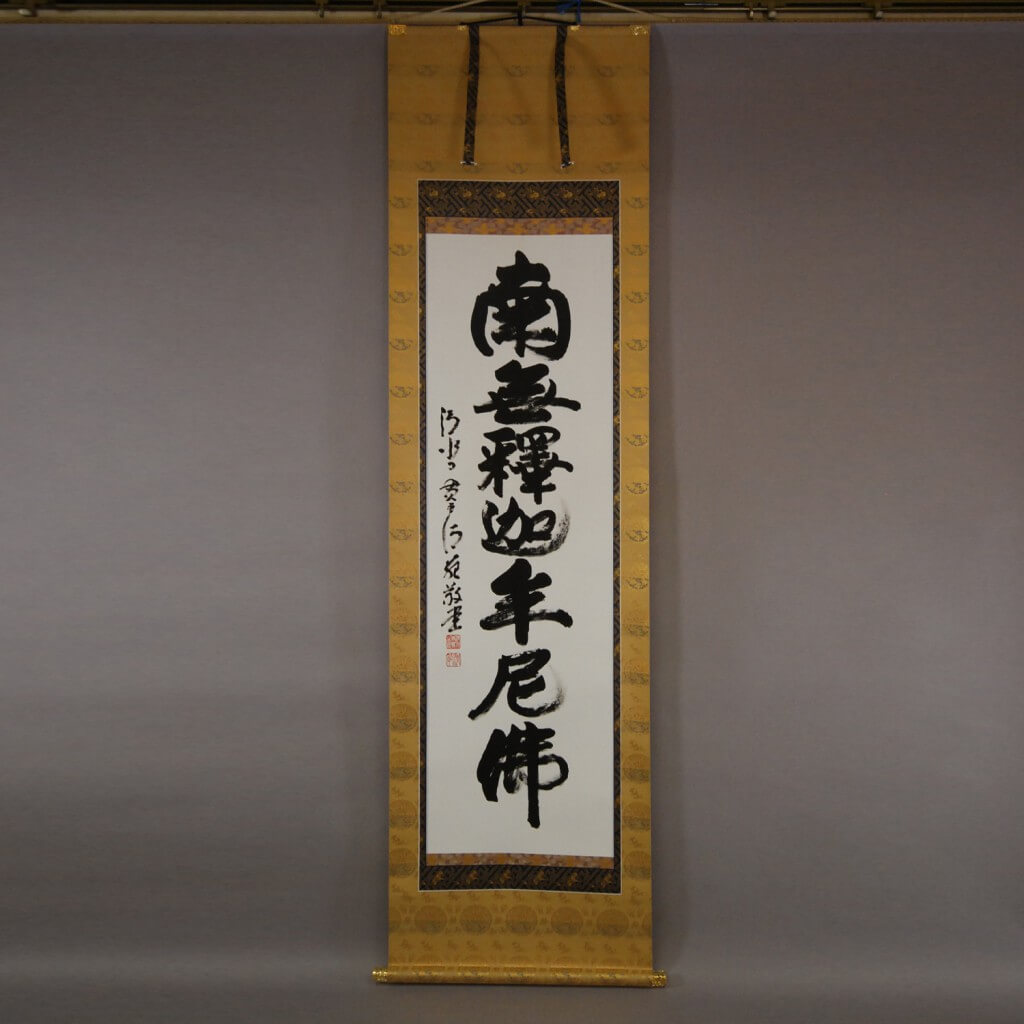
The Jizō is alternatively called ‘Shaka Myōgō’. Sōtō shū/sect, Rinzai shū and Ōbaku shū/are all the sect of Zen Buddhism whose Honzon is Shaka Nyorai, the founder of Buddhism and the reason why it is formed by ‘Namu-Shakamunibutsu’
Zen Buddhism was founded in China by Daruma / Bodhidharma the Buddhist monk from India and the sect places a significant value on re-experiencing the Zen mediation practiced by Shaka Nyorai when the deity reached enlightenment as a principal practice so as to achieve your own one.
A Kakejiku with the Jizō calligraphed ’Namu-Shakamunibutsu’ is generally seen at a Buddhist ceremony hold by Zen Buddhism. However there is a gap between the regions. Although both San-in region / Tottori and Shimane prefecture and Tōkai region / Shizuoka prefecture are the areas that boast the number of Zen temples they have, the largest and second largest in Japan, the kakejikus are regularly displayed in San-in region in contrast to that of Tōkai region the area hardly put on them to show. I learnt this utterly unexpected fact from my sales experience. I can speculate a number of the reasons and I did so at that time but I would rather not clarify it unless I find the evidence. A regional difference of displayable kakejiku is indeed very common even domestically and the difference mentioned above is the typical example.
One factor I could think of is the aspect of Zen Buddhism which places emphasis on achieving enlightenment thorough ascetic practices such as Zen mediation unlike Jōdo sects whose priority is to chant Myōgō. The approach of the practice is attaining enlightenment by gaining the insight into the nature of mind.
Namu-Daishi-Henjō-Kongō… Shingon Shū
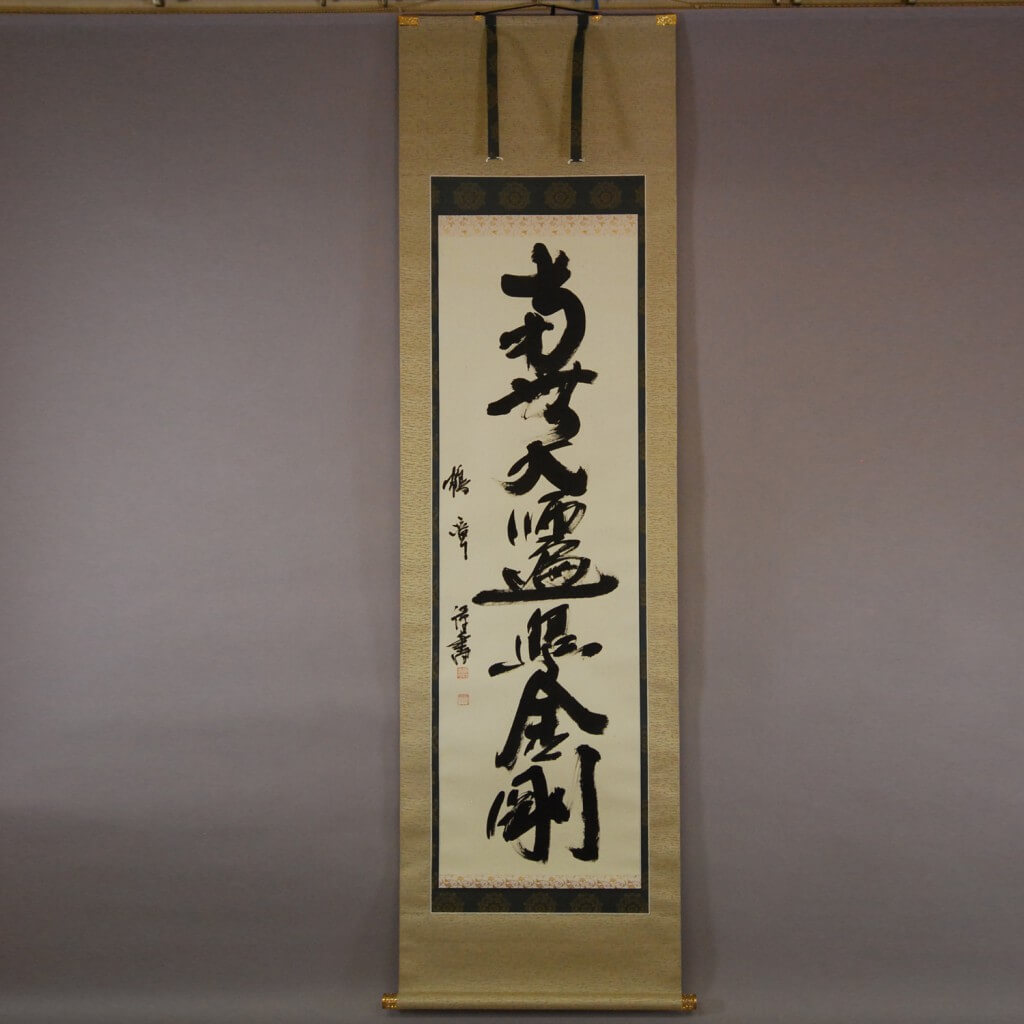
The kakejiku is meant for a Buddhism ceremony hold by Shingon shū/ sect and is also called ‘Kōbō Myōgō’. Unlike other Jizōs, this one ‘Namu-Daishi-Henjō-Kongō’ has a reputation of having the suffix to Namu which is somewhat difficult to understand. Honzon of Other Jizōs are fairly easy to imagine what it signifies but on the contrary, ‘Daishi-Henjō-Kongō’ is rather incomprehensible to many of us.
To start with, ‘Daishi’ represents Kūkai who founded Shingon shū/sect, also called ‘Kōbō Daishi’ which ‘Daish’ was derived from and ‘Henjō-Kongō’ stands for Dainichi Nyorai / Dainichi Buddha the central deity of Shingon shū.
‘Henjō’ denotes ‘to shine everywhere ‘…which is interpreted as ’to shine a merciful light on the entire world equally’. ‘Kongō’ can be translated as diamond in Sanskrit and means ‘something unbreakable and imperishable ’.
‘Henjō-Kongō’ a combination of these two words symbolizes Dainichi Nyorai with the meanings of ‘the imperishable Being who shines a merciful light on all of us equally’.
With that sense, ‘Namu-Daishi-Henjō-Kongō’ displayed and chanted by followers of Shingon shū refers to ‘I devote myself to and believe in Kōbō Daishi, Dainichi Nyorai’.
Even this Namu-Daishi-Henjō-Kongō, favored by Shingon shū as the kakejiku for their Buddhist service, is not necessarily the first choice in some regions.
I would like to detail it later that the kakejikus such as ‘jūsan butsu’ ‘Shingon jūsan butsu’, ‘Shikoku pilgrimage’ and ‘Hannya Shingyō /Heart Sutra’ are usual choices for a Buddhist service of Shingon shū.
The sect is under a principle that one can achieve enlightenment and attain Buddhahood in one’s lifetime thorough ascetic practices which is to integrate oneself with Dainichi Nyorai the entity of the universe and the absolute truth.
Namu-Myōhō-Renge-Kyō…Nichiren Shū
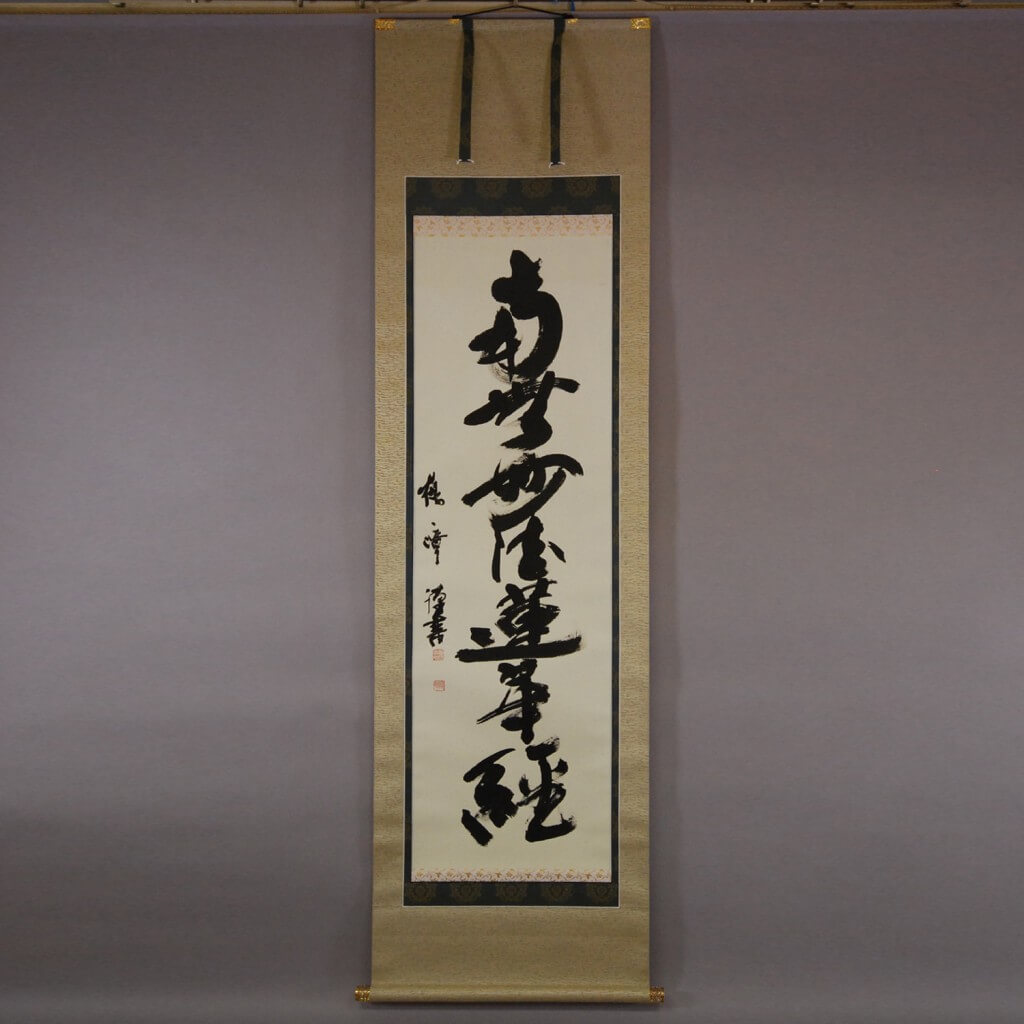
The Jizō shown above is called ‘Daimoku’ or Nanaji-Daimoku/Daimoku with seven Chinese characters’ and displayed at a Buddhist service hold by Nichiren shū/sect.
Since ‘Myōhō-Renge-Kyō’ represents ‘’Hokekyō / Lotus Sutra’ the Honzon of Nichiren shū, ‘Namu-Myōhō-Renge-Kyō’ is chanted and a kakejiku with the Jizō is displayed at their Buddhist memorial service.
The central deity is ‘Shaka Nyorai / Shakyamuni’ and the treasured sutra of the sect ‘Hokekyō’ is considered to be the essence of what the deity taught.
Displaying Mandala a.k.a. Hokke Mandala, Dai Mandala, Nichiren Mandara and Hige Mandala a script of the world of Buddhism inscribed by the founder Nichiren is the formal presentation of the sect.
The script ‘Namu-Myōhō-Renge-Kyō’ seen in the centre of the mandala above could be written in a single line calligraphy. – The style of writing is called Hige-moji/ beard character for its touch of script which grows like a beard.
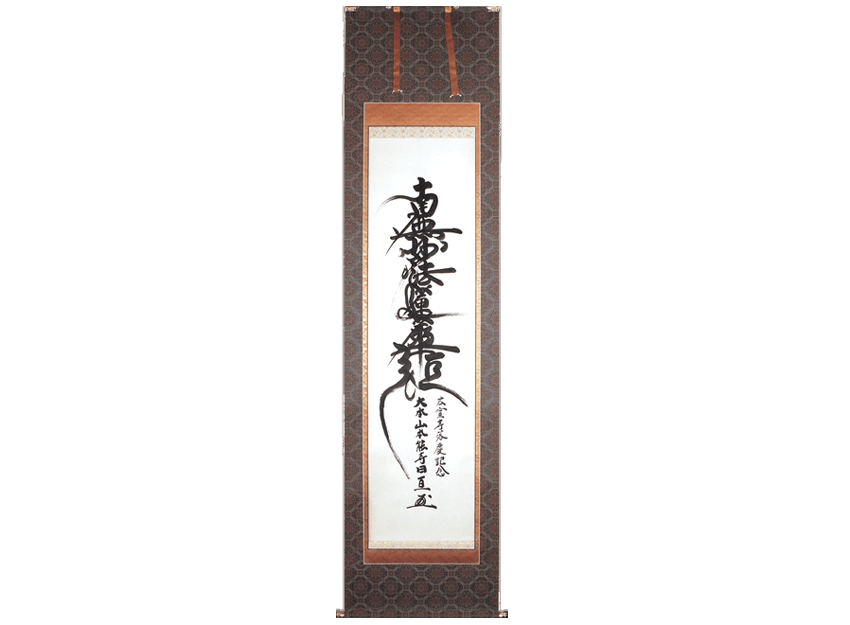
The common route for obtaining the kakejiku for parishioners to me is such route, a script inscribed at a head temple is then transferred to the branch temple whose monk is to place the mounting work order to kakejiku producers like us in order to send it to their parishioner once having the work done. – This is out of my experience so there would be other routes.
Regarding the belief of Nichiren shū, contrary to the aspect of the linage of Jōdo shū which aims to reach the pure land in afterlife, their concept is ‘All beings in this world are a possible Buddha thus this world we all live is the pure land. Endeavoring to transform this world into a better place is essential and this is what Hokekyō / Lotus Sutra upholds. Having a faith in Hokekyō converts this world into a wonderful pure land and no one fails to achieve enlightenment and attain Buddhahood.’ This different point of view used to arise frequent disputes between the two sects.
That is all for Jizō. I introduced the representative Jizō kakejiku of those sects by detailing the features of each denomination. I hope you got a rough idea of the characteristic and individuality of the sects I mentioned.
Then, let’s learn about the categories of ezō Buddhist kakejiku which does not consist of letters, calligraphy.
Ezō / Painted Image
Jūsan-Butsu
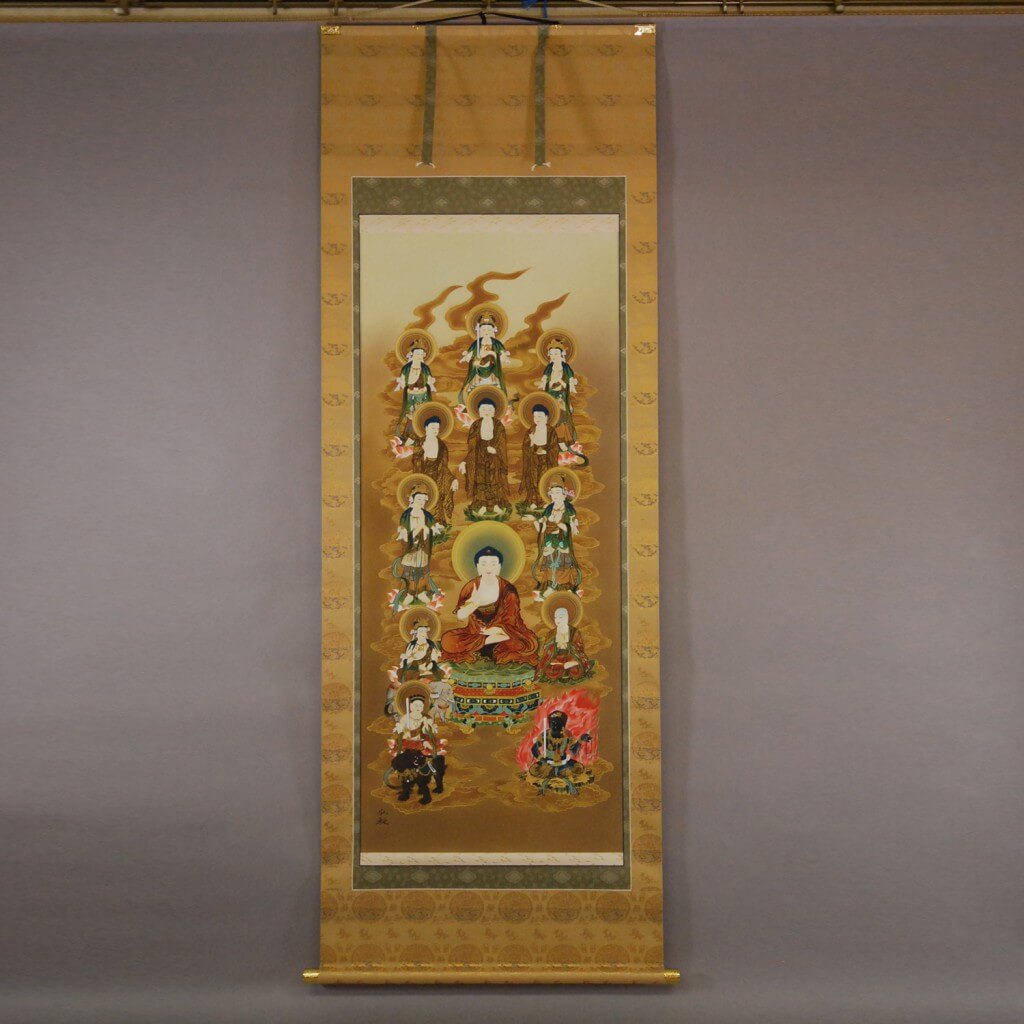
One of the ezō kakejiku presented for a Buddhist service which won a great acceptance is the ‘jūsan-butsu’ kakejiku literally depicts 13 Buddhas …Buddhas and Bosatsu/Bodhisattvas to be precise.
More specifically, the 13 Buddhas are Fudō Myōō・Shaka Nyorai・Monju Bosatsu・Fugen Bosatsu・Jizō Bosatsu・Miroku Bosatsu・Yakushi Nyorai・Kannon Bosatsu・Seishi Bosatsu・Amida Nyorai・Ashuku Nyorai・Dainichi Nyorai and Kokuzō Bosatsu.
Well these Buddhas…what roughly differentiates Nyorai from Bosatsu is the status of Nyorai which is gained by becoming Buddha after spiritually awakened. The Nyorai includes Amida Nyorai, Shaka Nyorai and Yakushi Nyorai and so forth…
I hear that Bosatus is a person performing ascetic practices to become Buddha.
‘Aren’t they? All those who are performing the practices are meant to be Bosatsu? So am I!?’
You might’ve been confused… and I was too but it actually doesn’t mean that way. (Never mind..)
Bosatsu primarily will attain Buddhahood, – Being qualified for the status, put it this way might help. – but vowed to remain on this world to aid other people in their achievement of enlightenment while staying beside them. The purpose of Buddhism, saving a large number of people and leading them to attain Buddhahood explains why these Bosatsus exist.
Kanzeon Bosatsu, Jizō Bosatsu and Kokuzō Bosatsu are one of those Bosatsus.
How about Myōō? This question may arise. . Myōō is the personification of Nyorai, so I suppose the answer is a Buddha.
Well, what’s the meaning of jūsan-butsu on which the 13 Buddhas are drawn? In fact, the purpose of Buddhist memorial service we hold is the key.
The story dates back to the end of Heian period (794-1185).
Around that time, the origin of jūsan-butsu as well as conception of Buddhism in China ‘Jūō-Shinkō / ten kings of the afterlife’ was introduced. Originally the subject was not Buddhas, was jūōs. Tradition has it that the ten gods like figures in Chinese Taoism were replaced with Bosatsu and Nyorai after being introduced to Japan and the number of Buddhas grew as the time went by and around the Edo period, the number developed into 13. To my surprise, jūsan-butsu is originated from Japan…I’m not sure about the change of the cast, done without permission…
Then, the job those 13 Buddhas are conducting is, in short, the judge of the dead and their role is accomplished in turns.
According to the belief regarding jūsan-butsu, one does not attain Buddhahood or reincarnates straight after they passed away as they are meant to be judged to decide which realm they must go based on the points of achievement earned throughout their lifetime.
The judgment won’t end in 1 or 2 times, there will be whopping 13 of them in total and yes, jūsan-butsu are the Buddhas who are in charge of.
The deceased first meet Fudō Myōō who takes charge of the first court to sit in judgment on them seven days after they passed away then after fourteen days of their decease, their visit to the second court for the next judgment sit by Shaka Nyorai follows. These visits continue up to 7 times to receive the verdict on which realm they are basically to go. Either attain Buddhahood or transmigrate Rokudō they will be destined to…
Allegedly in case, the verdict wasn’t brought in, a follow-up judgment is going to make.
The judgments are made every 7days up tp 7th one. It rings a bell? yes these are the seventh day, 14th day and 21st day Buddhist memorial service hold after a funeral. It is commonly said that Shijūkunichi / the forty-ninth day after one’s decease completes the first phase as the day is the day that 7th judgment is made for some of the deceased to decide their next realm to transmigrate and the duration of the forty nine days is called Chūin / period of intermediate existence between one’s death and rebirth.
I have a question for you.
On 7 Buddhist services before the forty-ninth day, you all gather and sit straight in front of the altar praying et cetera but, what’s all this for?
The answer is to hold ‘Tsuizenkuyō’.
I know the word made you puzzled. The meaning of the word is ‘a memorial service to add good deeds for the deceased’.
Well actually, support from our world is accepted at the trial by jūsan-butsu. There should be a case of the deceased on the edge, who doesn’t have enough points of good deed to attain Buddhahood in other words, who will fall into hell and the solution for such case is the remarkable arrangement which let us add up their good deed points by praying from this world. The total points will be the added up points from gathered people per head at each ceremony×7times. It must be a lot.
Therefore the gathered pray for the afterlife of the departed at 7 memorial services and following services of one hundredth day, the first and second anniversary of the one’s death and so on. But to whom? Yes indeed, to jūsan-butsu.
Consequently, putting on show jūsan-butsu kakejiku at a Buddhist memorial service has become a custom.
Having said that, jūsan-butsu kakejiku is not displayable for schools of Jōdo line as it opposes to their principal, teaching that one can reach the pure land straight after their decease if chants namu-amidabutsu during their lifetime.
‘Really!? My family supports Jōdo Shin shū and I’m sure memorial services of the sect are hold.’
Some of you may react in this way and well actually my family is the believer too.
As said by the sect, these services are not tsuizenkuyō but a preaching through the deceased as a special case…They must’ve a sticky moment to answer… Well, for me their approach is fair enough. During about 1000 years of history of Jōdo Shin shū, a variety of factors say, danka system in the Edo period, an involvement with other sects and individual regional customs must have exerted their influence on the sect.
Many of those who support Zen Buddhism and Shingon shū display the kakejiku. At memorial services of Shingon shū in particular, jūsan-butsu represented in Shingon shū style is occasionally displayed as well as the standard jūsan-butsu. In the ezō, Kōbō Daishi is arranged at the front with Dainichi Nyorai the Honzon behind surrounded by the rest of Buddhas. Jūsan-butsu with the composition is called ‘Shingon jūsan-butsu’.
An example of the kakejiku which is even more distinctive is the one from Okayama prefecture whose population is predominantly Shingon shū worshipper. This particular shingon jūsan-butsu kakejiku is shorter to place atop an alter which is for many cases, reassembled for every Buddhist service. How interesting. Like this example, kakejiku would vary to adopt a local custom and a display manner of worship.
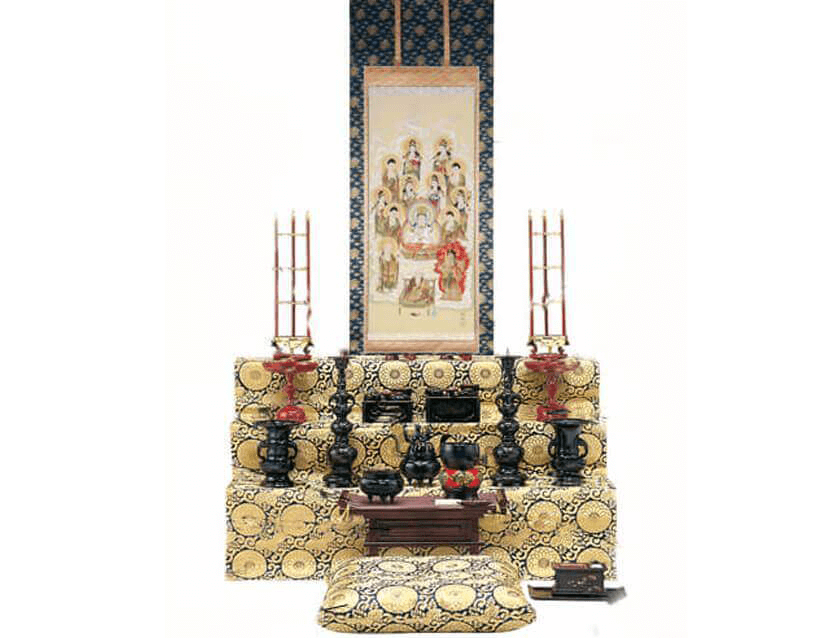
From my experience, I have never met any Nichiren shū believer who put on show jūsan-butsu kakejiku. That manner arguably reflects the notion of the sect that sees the world we live as the pure land and for that reason, they teach not to neglect ones lifelong ascetic practices being distracted by the conception of reincarnation in one’s afterlife.
That’s all about jūsan-butsu from me. A pretty long story but it’s because the kakejiku is popular enough to be displayed at Buddhist memorial services as the standard so I gave you the best possible explanation.
Let’s move on to introductions of other ezō kakejikus.
Kannon-Bosatsu / Kannon Bodhisattva
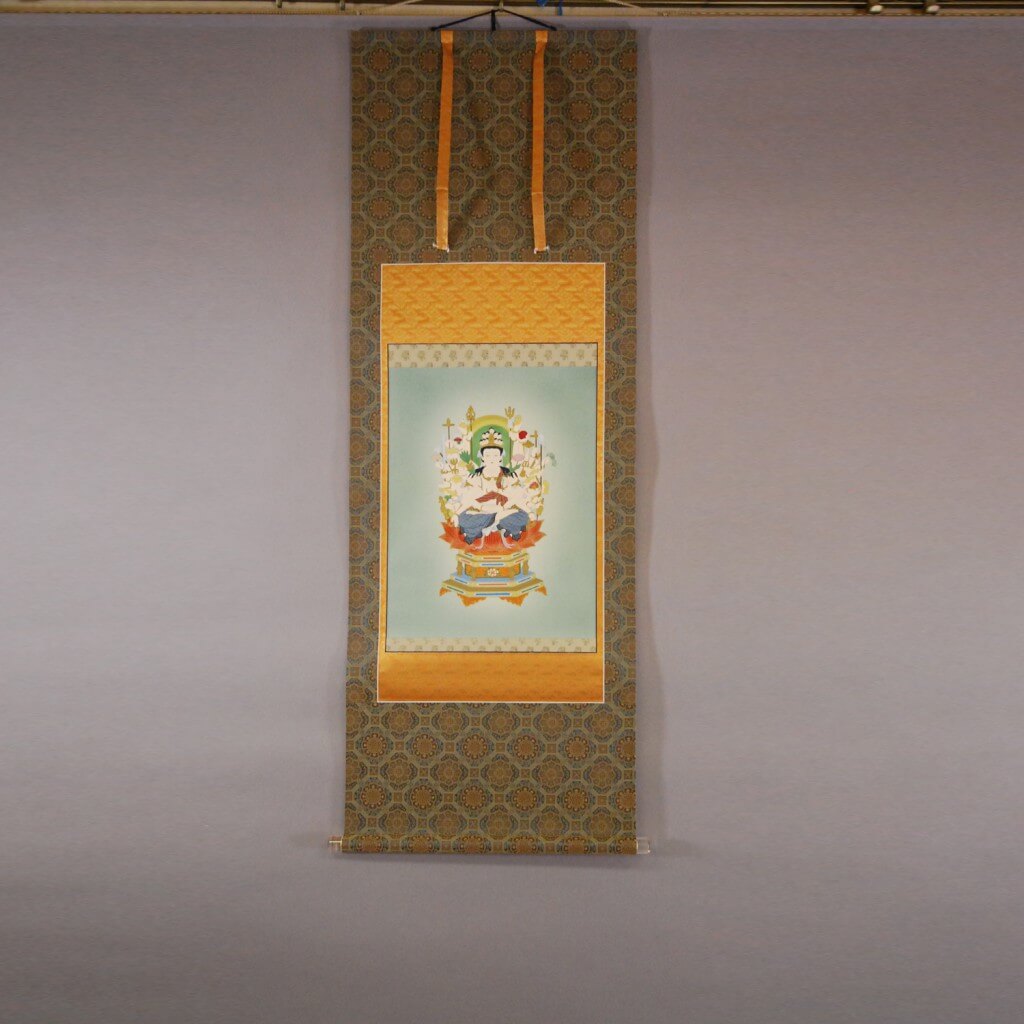
This bosatsu is one of familiar deities in Japan.
As I mentioned earlier at jūsan-butsu section, Bosatsus are those who exercise ascetic practices in order to aid other people despite already retaining the power to attain Buddhahood.
In Japan, the faith of Kannon-Bosatsu has a long history and the origin of the worship steps back into ancient time prior to denominations we have a faith in such as, Jōdo Shin shū etc. established in the Kamakura period (1185-1333) and Shingon shū etc. founded in the Heian period (794-1185).
Saigoku Sanjūsankasho – the 33 temples that are visited during the Kansai Kannon Pilgrimage has its origin in an order of Saint Tokudō following a rather outrageous oracle of Enma Daiō /King Yama which is to set a trend of making a pilgrimage to the 33 holy places of Kannon scattered around Gifu prefecture and other six prefectures in the Kinki region / Kyoto, Osaka, Hyōgo, Shiga, Nara, and Wakayama.
The legend was set in around the Nara period (710-794) therefore it is most likely that Kannon worship had reached Japan around the time.
Among number of sects of Buddhism we currently believe in, various conceptions of them have arisen from some sutra and considering numerous descriptions of Kannnon are found in many of these sutras, the bosatsu is a gracious existence non-denominationally and fundamentally.
The kannon is thought to help those in difficulty and suffering in the earthly realm, where we live to achieve salvation, in other words the existence for worldly interests and especially beloved by Japanese worshippers. As a Jizō, I often come across with ‘Namu-Kanzeon-Bosatsu’ and ‘Namu-Daiji-Daihi-Kanzeon-Bosatsu’ that embody ‘I have faith in Kannon-Bosatsu!’
Kannon transforms into many different forms to rescue us from all sorts of suffering in this world. If you could imagine a character of manga who changes themselves into the one specializes in the power, speed or unique ability depending on the enemy, Kannon, so to speak, shares the trait and the number of the forms is jaw-dropping 33. Isn’t it amazing?
The standard form will be Shō Kannnon / Sacred Kannon and Senju Kannon / Thousand Armed Kannon, and Byakui Kannon /White-Robed Kannon are well-known ones. There is even Kannon riding on a head of dragon literally called Ryūzu Kannon /Dragon Head Kannon. That one makes me curious, what does this transformation mean? I can’t get it out of my head…
Kakejikus of this Kannon is not only non-denominational but displayable as usual kakejiku which is often seen, so the use is not limited to presentation of Buddhist kakejiku. They fulfill the worldly interests so displaying the one must be blessed mustn’t it? I’d feel like having a lucky charm.
Amida Raigō-Zu / Image of the Descent of Amida Buddha
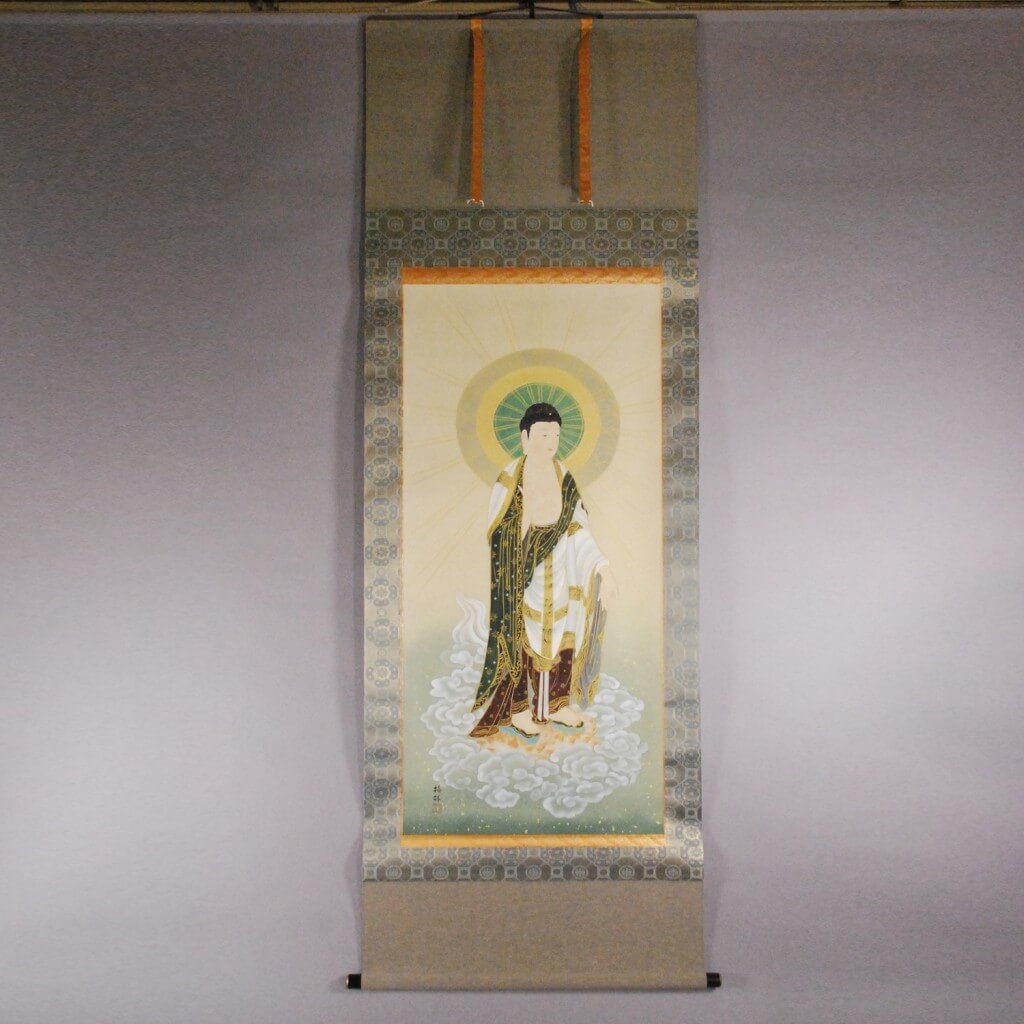
The ezō is literally portraying the descent of Amida to escort us back to his pure land. It differs in details of Amida’s image that can be Amida Nyorai himself, being accompanied by Seishi Bosatsu and Kannon Bosatsu as if they are his subordinates, taking even more Buddhas along with him, facing diagonally and facing the front.
The ezō is displayed mainly by the lineage of Jōdo sect but not a typical household choice. Although a large number of temples own them assumingly.
Around the end of the Heian period (794-1185) to Kamakura period (1185-1333) the time sects of Jōdo lineage were established in Japan, Mappō Shisō / the end of the world belief began circulated.
Most of religions have a thought that their teachings degenerate with the passage of time and the highlight of their history is the time of the establishment.
Buddhism is no exception with the belief that the effect of the disciples of Shaka Nyorai is able to uphold up to around 500 to 1000 years after the decease of the Buddha and during the period all of us can attain Buddhahood. The period is called Shōbō / the True Dharma Age then, the next period is Zōbō / the Imitation Dharma Age which only resembles Shōbō and the final period is Mappō / the Last Dharma Age the period that ‘only teachings is extant and people will never reach enlightenment no matter how hard they train themselves.’
Worse still, this Mappō age is meant to last for 10,000 years…Dreadful isn’t it.
The mappō age supposedly has begun in the year 1052 in Japan. This period was exposed by such social unrest to the extent that the nation at that time believed the notion. The nobility started focusing on only their own success neglecting politics, the appearance of the rampaging samurai, the monk, supposed to be the last hope tuned into armed warrior monks or were engaged in a power struggle in collusion with the nobility. In Kyoto, dead bodies of common people piled up on the street and liver were consumed by the population merely for their survival. The period was truly hellish and is beyond belief in modern times.
Conception of the pure land drew the attention of common people who couldn’t see any glimmer of hope in their life and were desperate to be aided in a positive rebirth. Apparently in Japan, the notion of the pure land had been around by that time yet such historical background had a major impact on the conception of those people making them even more determined to reach the world in afterlife.
Besides, around the period, the introduction of Jūō-Shinkō the origin of jūsan-butsu mentioned above prompted a rapid spread of the notion of afterlife in Japan where a perception of afterlife had been ambiguous. For instance, at the beginning of Saigoku Sanjūsankasho, Saint Tokudō came and went between this life and afterlife and similarly the Nihonshoki / chronicles of Japan inscribes that Izanagi visited yomi /the world after death chasing Izanami who passed away and swiftly retuned to this world escaping from her who had turned into a monster. These legends tell how vague the boundary was.
Then Jūō-Shinkō was introduced and consequently the conception of afterlife was remarkably clarified. The awareness of the world was dramatically raised and the existence of the pure land became something those people yearned for.
This world is beyond salvation so I just wish for my happiness in afterlife.
→ I hear that there will be the pure land in afterlife.
→ Amida is said to descend from above to welcome the souls of the dying into Amida’s pure land.
→ Let’s pray to Amida Nyorai.
There should be a train of thought like the above – It’s my assumption though – which led to the foundation of ‘Amida Raigō-Zu an image of the descending of Amida who is to escort us to the pure land’. Numerous and wide-ranging artworks with the ezō drawn during the end of Heian period are still extant nowadays proving the firm faith in the Buddha in those days.
The faith in Amida provided the foundation of Jōdo and Jōdo Shin shū and this is why quite a few believers of Jōdo shū display a kakejiku calligraphed ‘Namu-Amidabutsu’ and those which with Amida Raigō-zu are favored as the additional choice by the devout believers.
Daruma / Bodhidharma
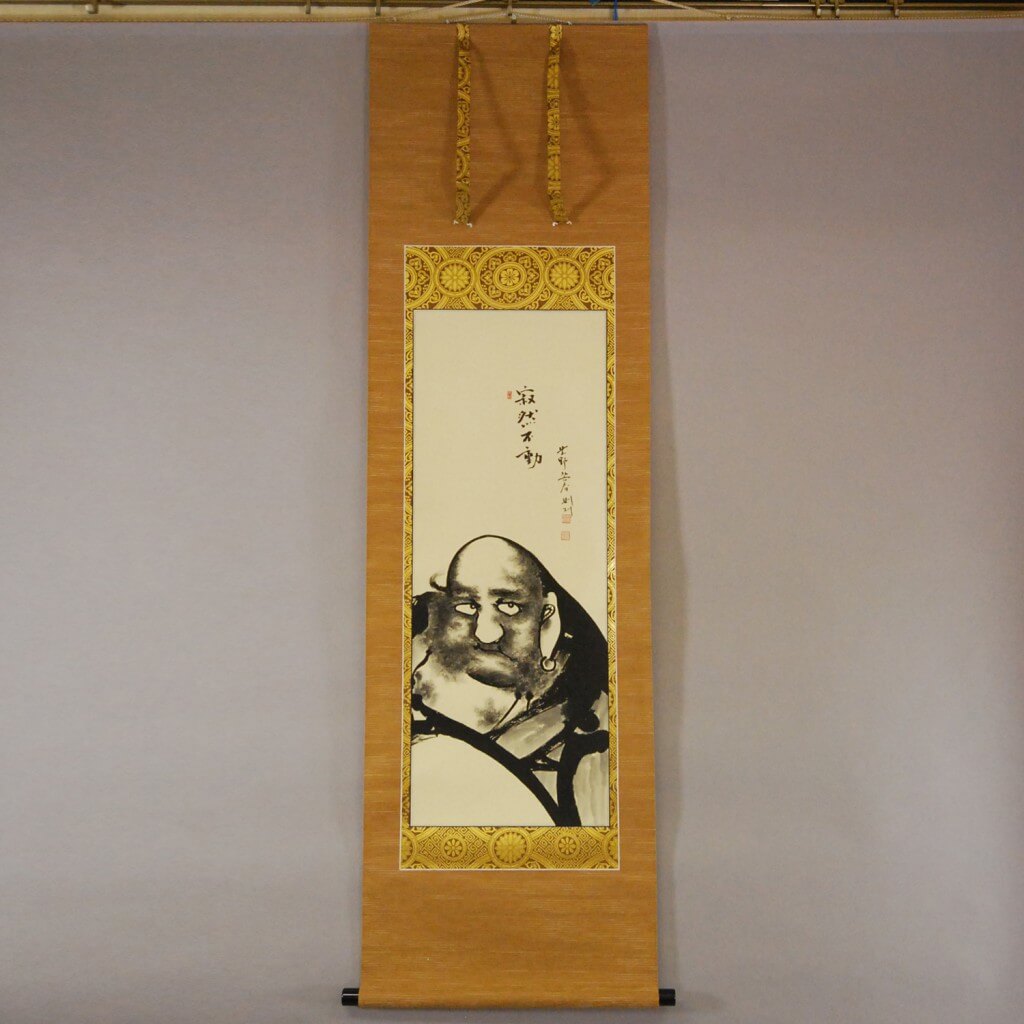
Darma is the founder of Zen Buddhism. He was originally from India and credited with the religion’s introduction to China.
Kakejikus with the ezō are occasionally put on show by the faithful of Zen Buddhism. However I have an impression that in many cases they display the kakejiku as usual kakejiku rather than the one for Buddhist service.
The principle of Zen Buddhism is attempting to understand the meaning of life through the practices Shaka Nyorai performed such as Zen meditation. In order to reach the state without being misled by language, communicating the nature of Buddha direct from master to pupil within their mind is essential for the religion. An expression ‘Ishindenshin’/ unspoken communication has roots in the Buddhist terminology of this practice method.
For that reason, the master is well-regarded in Zen Buddhism. When a disciple attains spiritual awareness, the Zen master gives them a kakejiku called Chinsō / Chinzō, a portrait of the master that includes hōgo / Buddhist sermon as a certificate. Chinsō is treated as if it is the master themselves with great care by pupil.
The portrait can be made during a master’s lifetime and handed to their student as well as after their decease. We also have taken a couple of orders that were to mount Chinsō.
Supposedly the ezō of Darma is displayed due to the worship given to him as the founder of Zen Buddhism, the ultimate master of masters.
If you are not sure about displaying Daruma kakejiku at Zen Buddhist service as a Buddhist kakejiku, I do recommend consulting your temple for the answer. Doing so can minimize possible troubles as the temple of which you are the parishioner is meant to be well acquainted with the local views and customs that determine the right kakejiku.
In my opinion, you wouldn’t be reprimanded over your choice of kakejiku by monks of Zen Buddhism sects when it’s done in moderation. Obviously displaying Sansui and Takasago and the like as well as Myōgō belonging to other faith will be the wrong options, still aside from those, I’ve never heard any case of being told off by selecting Namu-Shakamunibutsu, Darma and Jūsan-butsu kakejiku.
Zen’s principle emphasizes the attainment of enlightenment by one’s potential so that I imagine the sects are not on the strict side when it comes to the regulations of their memorial service.
– Although I guess it’s not always the case.
Reijō Shūinjiku / Kakejiku with Stamps of Temples Collected during a Pilgrimage
Saigoku Sanjūsankasho / The 33 Temples That Are Visited during the Kansai Kannon Pilgrimage
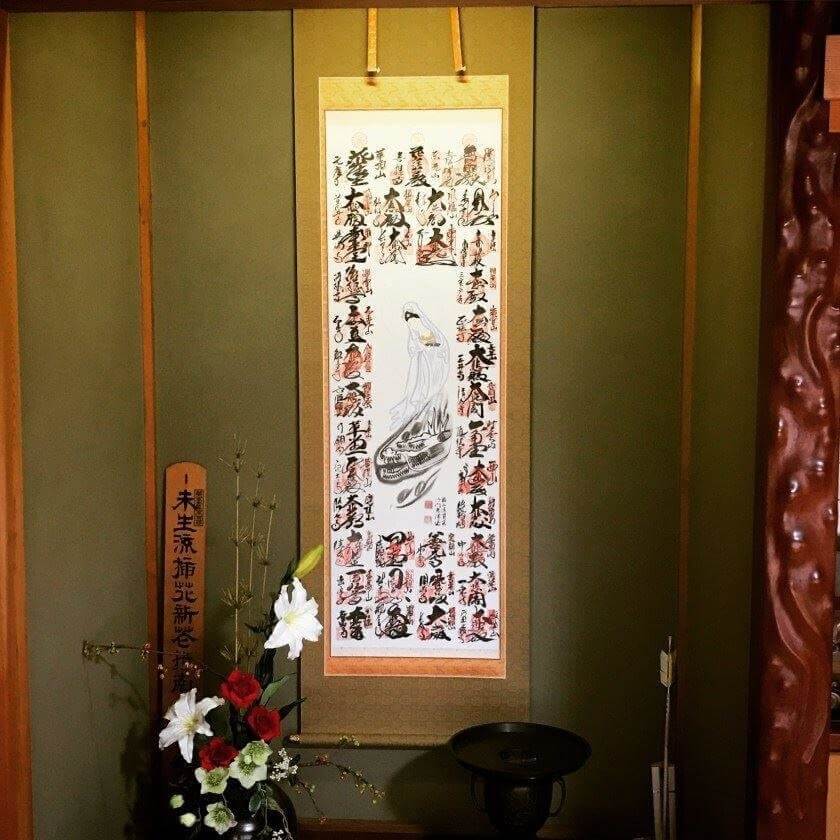
Reijō shūinjiku the originally plain nōkyō-jiku /prayer kakejiku designed for obtaining stamps that are collected in order from pilgrimage sites, would be displayed for certain cases.
Sacred places are found all over Japan so types of reijō shūinjiku are diverse but still two major kakejiku of those in the Kansai region will be Saigoku Sanjūsankasho and Shikoku Pilgrimage.
Saigoku Sanjūsankasho is kakejiku completed by making a pilgrimage to the 33 holy places of Kannon in Gifu prefecture, other six prefectures in the Kinki region and additional few temples.
As I mentioned in above Kannon section, Kannon worship has a long history in Japan and since the Kannon bosatsu has been a subject of worship non-denominationally, Saigoku Sanjūsankasho also became oriented to non-denominational kakejiku. The usage is not limited to presentation of Buddhist services and it is often presented as usual kakejiku.
I’m afraid if I sounded persistent but as I mentioned, please confirm the correctness of displaying your kakejiku for a service with the temple of which you are the parishioner. I have to note that especially the lineage of Jōdo and Nichiren shū are inclined to display those which are Namu-Amidabutsu and Namu-Myōhō-Renge-Kyō.
Shikoku Pilgrimage / Shikoku 88 Temple Pilgrimage
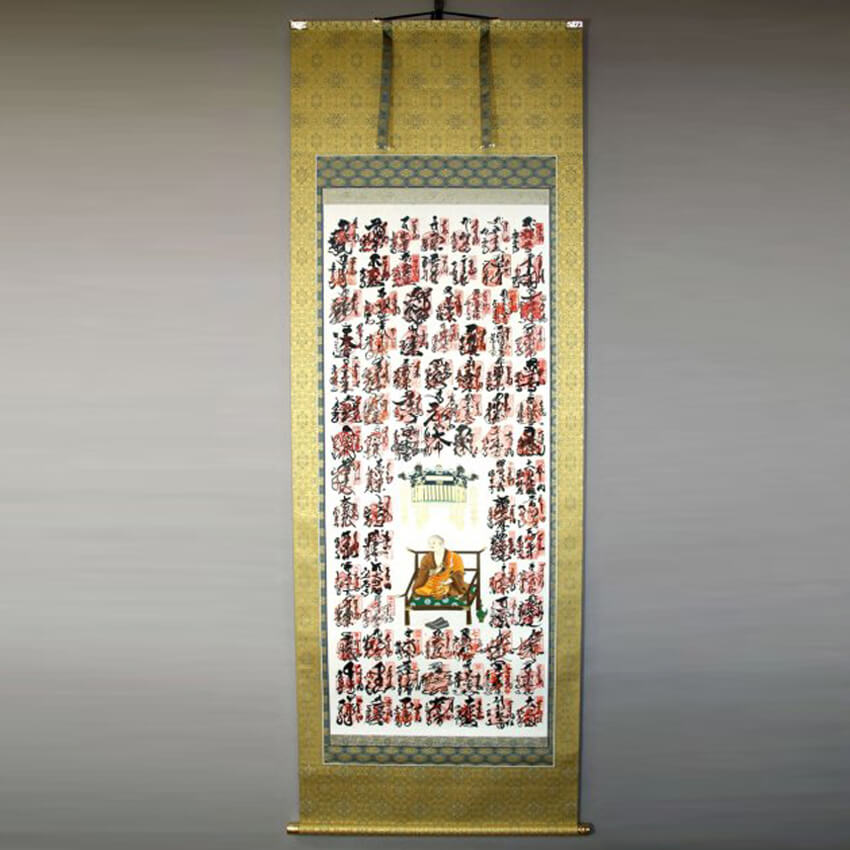
The other well known sacred place is Shikoku Pilgrimage known as ‘O-henro’. The trail of the pilgrimage connects 88 temples associated with Kōbō Daishi / Kūkai that are scattered across the island of Shikoku.
There are cases of the kakejiku being displayed at a Buddhist service of Shingon shū. However, there are always those who require a mounting work for their nōkyō kakejiku regardless their sect. They have their own sentiment and motivation to make their pilgrimage so speaking personally; there shouldn’t be any restriction on the sect they follow.
More and more foreigners have been making the pilgrimage and we frequently receive those inquiries. We also mounted a shikoku pilgrimage kakejiku for a Swiss customer who himself is the pilgrim and the episode is available to watch at our video series so why don’t you take a look? (English subtitle is available.)
A non-denominational mount of nōkyō kakejiku which in its center, Myōgō of a chosen sect is written is available these days. I would suggest making your pilgrimage with the mount as it enables you to complete the Shikoku Pilgrimage kakejiku of your own denomination.
Summary
I hope you enjoyed my interpretation.
I introduced a wide range of Budhhist kakejiku and I would be pleased if it helps you with the right option of kakejiku for your denomination.
Moreover, I believe that the better understanding of Budhhist kakejiku in each category makes usual memorial services all the more worshipful.
Contents Link
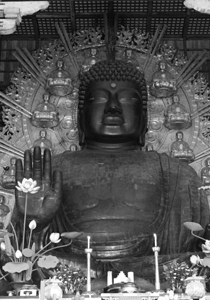 Japanese Buddhism Japanese Buddhism |
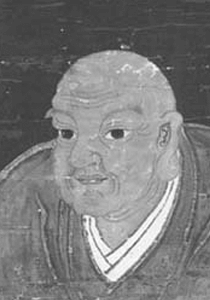 History History |
 What Is Hōyō? What Is Hōyō? |
 Buddhist Kakejiku Buddhist Kakejiku |


